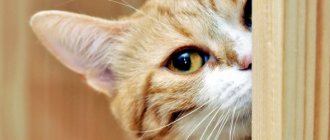Habit of sleeping with a person
They used to say in ancient times that if you sleep in the same bed with a cat, you might get frogs in your head. To a modern person such a legend may seem funny, but if you think about it, it is not without meaning. Imagine the life of a cat, at least a hundred years ago: no vaccinations, walks through garbage dumps and barnyards, free contact with stray animals. Such a pet could “reward” its owner not only with frogs, but also with something worse.
There are many theories explaining why a cat likes to lie on a person. The first of them is esoteric, explaining how cats heal people. Its essence is that a person is like a large battery in which the positive pole is located in the head area, and the negative pole is in the legs, and all the negativity accumulates there. Lying on its feet, the cat takes away negative energy, in other versions it transforms it into positive energy.
Another explanation for why a cat often sleeps on a person is more prosaic: a person, in this case, is nothing more than a source of heat and acts as a heating pad for the animal. The warmest places on the body are the head and the projection zones of diseased organs; cats especially love them and try to lie there. They owe their reputation as healers to this property, and they lie on their legs only because they could be swollen or the owner has problems with the joints. By the way, the Sphynx breed is considered the most “healing” in the cat family; it is suitable even for people prone to allergies.
Another possible reason is the desire for comfort. For a domestic animal, a person is the embodiment of a protector and provider; proximity to him in a dream gives the cat a feeling of security when it cannot observe what is happening around. They are usually driven away from the head or body or hidden under a blanket, which not everyone likes; they have to be content with little, which is why cats usually sleep at their feet.
Theory number four - the animal controls the person in this way. Lying on it, the easiest way is to follow its movements and not oversleep the most interesting part.
And finally, the last theory why a cat sleeps in its legs is scientific, based on its natural characteristics and habits. In cat communities there is a strict hierarchy in which the weakest occupy the lowest level. By lying on their feet, they show their subordinate position and recognize the primacy of the strongest, in this case, man. But if a pet tries to settle on its head or on a pillow, it’s worth asking the question: “Who’s the boss in the house?”
Why do cats like to sleep at their feet and not next to them?
Cats like to sleep at their feet, not next to them, or do not approach their faces, often due to the hierarchical nature of the relationships between animals, both among themselves and with humans. A cat or cat, which, due to its temperament and disposition, does not claim a leading role in the community, most often chooses a place to sleep at the feet of the owner. With this behavior, the pet shows that it views the person as a leader and leader, recognizing its secondary role.
According to experienced breeders, the location of a cat in the blood is influenced by the character of the pet and its sense of security. If the animal is calm about human movements during sleep and is not bothered by changes in position, then the cat sleeps with pleasure next to the person. However, a shy, fearful pet prefers a safer place - at the feet, since compared to the human body, the legs have less weight and do not frighten the domestic couch potato as much.
A cat who loves comfort and does not tolerate a familiar attitude towards him will never choose human feet for rest.
Sleeping on the table
It was believed that if a cat took a fancy to the table, it meant the death or illness of one of the household members, and if it liked to lie on the kitchen table, it meant it was trying to get the man out of the house.
This terrible omen also has a basis. Animals that led a semi-wild lifestyle in ancient times were carriers of many diseases, which ultimately led to sad consequences. And a man’s departure is inevitable if he constantly gets cat hair in his food.
From a scientific point of view, everything is more prosaic; in nature, cats are excellent at climbing trees and climbing up hills because... From there it is easiest to monitor what is happening around them, so the table is a good observation point for them and nothing more.
Why does a cat sleep between husband and wife?
Spouses sleeping in the same bed cannot be separated, but what to do if a pet constantly lies between them. Cats and cats should not be offended; they are considered the guardians of the hearth. Without them, home is not so warm and cozy. But they have absolutely no need to sleep in the marital bed, especially if the purr is not located at the feet, but stretches between the spouses. In this case, the animal interferes with the energy exchange that takes place between husband and wife during joint sleep and rest, appropriates part of it for itself, which is why the spouses may soon quarrel.
If a cat persistently lies on the owner’s stomach, this may mean the imminent birth of a baby. Purrs sense a new, nascent life even before home tests begin to detect pregnancy.
Whether or not to allow the cat to sleep in the bed is up to you. The right solution would be to equip your pet with its own place to sleep. It is not at all difficult to train a pet to sleep separately if you adhere to the following rules:
- buy a cozy bed and comfortable bedding at the pet store;
- determine the pet’s favorite place in the apartment;
- organize the sleeping area so that the cat feels comfortable and spacious in it;
- provide the cat with a good view of the room from its sleeping place;
- place the pet's sleeping place on a slight elevation;
- If your pet doesn't object, cover his bed with a lid.
At first, until the cat learns to sleep separately, close the door to the matrimonial bedroom at night. The purr will have no choice but to climb onto the soft bedding, curl up in a ball and sleep, gaining strength for an active pastime.
Sleeping on his back
There is a sign: if a cat sleeps on its back, with its paws spread to the sides, wait for a thaw. If the pet is looking for a place to warm up, frost will strike. These furry barometers can predict weather changes and respond accordingly. Our observant ancestors noticed this long ago.
Modern science considers an animal sleeping in an unprotected position, with its belly open, as simply the highest sign of trust in its owner.
Sleeping together between a cat and its owner
For humans, spending time with a pet like this is not dangerous, so there should be no cause for concern when sleeping together. Cats love the smell of their owner and everything that he emits, so the animal does not miss a single opportunity to lie next to a person.
Negative aspects
You should not sleep with an animal on the same bed in the following cases:
- Restless sleep. When a person often tosses and turns, turns from one side to the other, you can inadvertently crush the paw or tail of an animal. In addition, cats sleep soundly and may not find their way in time. In this case, it is better to give your pet a separate sleeping area;
- Allergy to wool. Some people react particularly sharply to cat hair, they begin to sneeze, runny nose, and exhibit other allergic symptoms;
- Woman's pregnancy. It is recommended to wean your pet from the habit of sleeping on the same bed with its owner, since when the child is born, he will constantly be next to his mother;
- Birth of a baby. The proximity of a cat and a baby on the same bed is not recommended in order to avoid injuries from both the child and the pet. If a cat walks outside during the day and sleeps at home at night, it is worth limiting his access to the master’s and children’s beds, as he can bring home an infection or some parasites, infecting the baby.
You can't look a cat in the eyes
It is believed that cats are connected with the world of the dead and can communicate with the inhabitants of the astral plane, who often inhabit them and thus end up in our world. Therefore, looking into the eyes of your pet, a person risks being captured by a hostile entity and becoming possessed or seeing his own death there, by the way, this is one of the reasons why some people prefer not to photograph cats.
Science on this issue, oddly enough, agrees with the mystics, but for a completely different reason. Direct gaze into the eyes is considered a manifestation of aggression in the animal world, so do not be surprised if the fluffy, in response to a long look, suddenly tries to attack you. Ginger cats are the most hostile to staring.
If a cat comes to your feet and licks itself
If a cat comes to your feet and licks itself, this behavior usually indicates the animal’s trust and affection for the person. Licking fur is considered by zoologists as a ritual of “shedding” one’s scent. Manipulation helps the pet find a common language with its relatives.
In relation to a person, a cat acts in the same way, considering him a member of his family. Therefore, if a pet climbs into the legs and begins to lick itself, then this behavior indicates that the cat trusts and feels gratitude and love for the family member.
Cats are not allowed to be photographed
Besides the threat of facing your own death ahead of time, there are three arguments against photographing cats:
- Photography can shorten your pet's life. There is an opinion that the image takes away his soul, and this only affects cats, and forces cats to leave the house. The theory is very controversial, as is the fact that cats have a soul.
- Flashlight can impair an animal's vision. A completely reasonable statement. Cats are nocturnal animals and their eyes are not adapted to intense light exposure. There may not be any long-term or irreversible effects on the eyes, but perception may be temporarily affected.
- He may feel stressed and afraid. This is true and especially true for animals that are not accustomed to posing in front of cameras.
We should also not forget that cats are indifferent to photography, people need it, therefore, for the sake of your own ambitions, you should not jeopardize the health and comfort of your pet.
Is it possible to sleep with a cat?
Most people love to sleep with their furry pets, which add extra coziness and comfort to the bedroom and have a calming and relaxing effect. But there are a number of contraindications for sleeping together with cats:
- increased tendency to allergic reactions;
- the period of waiting for the baby to be born;
- somnambulism and sleepwalking;
- age category of a child under 3 years old.
Only a domestic cat that does not go outside and does not come into contact with other animals can be allowed into your bed.
Otherwise, the risk of contracting infectious and parasitic diseases, which are most dangerous for children, increases.
Vampirism
There is an opinion, which has not yet been scientifically confirmed, that cats are energy vampires and people very quickly become dependent on them. Some people really call it love.
Avid cat lovers also claim that cats only take away negative energy and they do this when they press their warm tummy to you. That is why they love to lie exactly where the owner or mistress is experiencing pain, relieving unpleasant symptoms; older people especially like to be treated in this way when a large bouquet of sores is collected, the heart is playing naughty and the pressure is jumping. Well, all that remains for now is to take this hypothesis on faith.
Why does a cat sleep near a child?
The pet itself chooses a family member at whose feet it will sleep, and often it turns out to be a child. Whether or not to let a purr into a child’s bed is up to the parents to decide. If the cat is clean, domestic and affectionate, there is nothing wrong with sleeping together with your baby. By putting it into a crib, a pet demonstrates its devotion to its little owner. There is nothing strange in the fact that a cat sleeps next to a child:
- children smell deliciously of milk, the house purrs really like this smell;
- a child, unlike an adult, will never drive a cat away; rather, on the contrary, he will hug him and press him to himself, bury himself in the soft fur;
- an adult cat understands perfectly well that the child is small, which means he needs to be protected and protected; by falling asleep next to him, she takes a kind of guardianship over him.
A fluffy pet lying nearby helps the baby calm down and fall asleep faster. The baby is pleased when he is not alone at night, a warm and comfortably purring cat is next to him.
Purr
There is a belief that a cat predicts the outcome of a situation with its purring:
At the patient's bedside - a speedy recovery.
Sitting on a suitcase - an easy road.
In preparation for the wedding - a happy family life.
Fishermen have a rich catch.
On the guest's lap - a good relationship.
Purring, or rumbling, in cats usually accompanies a state of pleasure, hence the sign - if the cat is happy, then everything will be fine.
Sound originates in the muscles located around the vocal cords, which begin to vibrate under the influence of electrical impulses from the cerebral cortex. It is worth noting that not only cats can purr, but also many other animals: hares, foxes, badgers, bears and even elephants.
How cats choose who to sleep with
A cat’s choice of whom to sleep with is influenced by the animal’s individual characteristics, its morals, and attachment to a particular family member. Some pets happily relax with the head of the family, climbing on the man’s head or chest, or prefer to sleep at the feet. Other cats choose only their owner to sleep and categorically do not want to sleep next to their husband.
Scientists explain the choice of a pet not only by its attachment to a specific person, but also by the theory of smells. Long-term observations of mustachioed friends have shown that it is the smell of a person that is decisive for a cat in matters of friendship and love. If an animal considers him “one of its own,” then it recognizes this person as a leader, leader, and gladly chooses him as a companion during sleep.
The cat is licking or scratching
The habit of cats to lick and comb themselves from morning to evening is reflected in folk signs and, as a rule, promises the arrival of guests or a change in the weather. In fact, the reason for this behavior is not climatic conditions, but a natural desire for cleanliness. A cat will lick anything that seems dirty to it, including its own owner.
Moreover, her concepts of cleanliness do not coincide at all with human ones: hands washed with soap will be licked just as mercilessly as dirty ones. This habit also extends to open wounds, surgical sutures, and bedsores, so veterinarians hinder the process by putting a special collar on the animal.
The second reason for this behavior is the maternal instinct, the pet shows love and care, and the person acts as a child.
Interesting facts and signs about cats
Cats, despite their “domestic” nature, are considered the most mysterious animals on the planet. There are a lot of signs and beliefs associated with their behavior.
For example, a cat moves its paws on a person’s chest or back - what does this mean? Scientists say that an animal performs a similar manipulation when it completely and completely trusts its owner. The movements are identical to those that kittens make in childhood, at the mother's breast.
A cat sleeping on the table will bring trouble to the house. This opinion was formed in ancient times, when animals were considered carriers of many diseases and infections. In fact, the popular belief is a myth - scientists are sure that cats choose the table as the best observation point in the house.
A cat sleeping on the threshold communicates with a brownie. This sign still has its relevance. It is believed that the threshold of a house is the line that protects the energy of each home. The cat is placed there as the main protector, preventing negativity from reaching other household members.
A cat's behavior predicts the weather : a pet sleeping on its back hints at an imminent thaw, and a cat curled up in a ball tells you that cold weather is approaching.
How many hours a day do adult cats sleep?
After the fifth week and until the cat's first year of life, as we said earlier, kittens sleep only 65% of the time. However, once a cat reaches adulthood, the average number of hours a cat sleeps increases again.
This sleep time for cats increases to approximately 70% and 75%, that is, 15 or 16 hours a day. Typically, it takes one year before the cat reaches adulthood. This time, however, depends on the cat's breed, as some breeds will take longer to reach adulthood.
Despite these long periods of rest, an adult cat does not sleep for 16 hours straight. These 16 hours of sleep are usually broken up by cat naps throughout the day. During this sleep, you will notice that your cat wakes up quite easily.
In fact, a cat falls into deep sleep once or twice a day. You've probably also noticed that cats can fall asleep anywhere!
Features of cats sleep
All people are surprised that the cat sleeps constantly, saying that she is very lazy. But this is absolutely not true. The duration of sleep for this pet is determined by nature. He sleeps on average 16 hours a day.
Cats are predators, so they need a lot of strength to carry out intense work in a short period of time. It consists in the fact that the animal watches the victim, carefully creeps up to it and then sharply attacks.
© shutterstock
This only takes a few minutes, but during this time the cat expends a lot of energy, which it then restores when it sleeps. During the resting process, the predator’s food is slowly processed in a state of rest and silence. That is why the pet’s body experiences a constant change of work and rest.
Even when a cat is sleeping, it is always on the alert so as not to miss possible danger. Their rest can be a light half-sleep, in which the pet maintains a position that would allow it to quickly move on to escape. After all, few owners know that a cat, when sleeping and in a motionless state, can develop maximum speed when it feels threatened.
In these pets, sleep consists of two phases that replace each other:
- Slow. It differs in that muscle activity gradually decreases, blood pressure and body temperature also drop slightly, the heart begins to beat less frequently, and breathing slows down. In this case, the eyes also move slowly at first, and then stop moving altogether when deep sleep occurs.
- Fast. In this case, when the cat sleeps, the heart rhythm and breathing rate regularly change, the eyes make rapid movements, and the pressure and body temperature rise slightly. You can notice that at this moment the animal twitches its paws or tail, releases its claws, moves its ears, and sometimes can even make some sounds. Although the animal is sleeping, it is still in a state of full combat readiness.
Scientists have conducted a lot of research into how cats sleep. Based on their results, they claim that during the REM phase, pets experience emotional and spectacular dreams. Moreover, most often they dream about how they explore the surrounding places, hunt for prey, and experience anger or fear.
How many hours a day does a cat sleep?
If you're jealous of your cat for the number of hours he spends sleeping each day, don't worry, you're not the only one! Whether your cat sleeps in your head, on your chair, in the sun, on your computer, or in the strangest and most unlikely places, know that cats are comfortable everywhere!
Although it seems incredible, a cat's body needs everything in order to stay healthy. Are you wondering why cats sleep so much? If yes, don't miss reading this article where we will discuss how many hours does a cat sleep per day.
Cat instinct
Cats are territorial, attractive and sociable animals. Every square centimeter of their home is their territory. Thus, as kittens they are already dedicating themselves to patrolling and exploring every corner of their new household.
This instinct of a cat, like any other animal, is to understand their territory and habitat. Cats want to know about everything around them in order to feel safe.
Cats will be affectionate with all family members. They will play, beg for attention, and often make everyone in the family love them.
However, it is normal that there is one person they prefer more than others and will most likely decide to sleep with. If your cat likes to sleep on the legs of a particular person in your family: it's because that person is his favorite.











